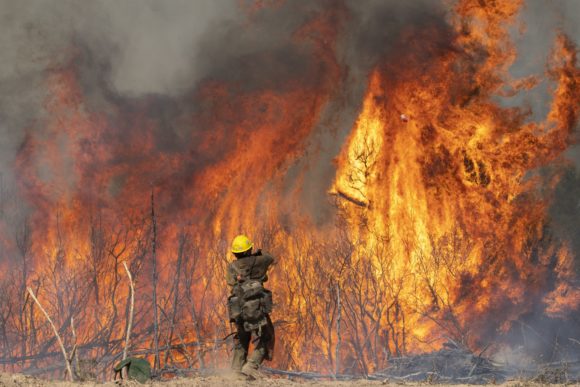To suggest that the property/casualty insurance industry should count its blessings in the year of the coronavirus is by no means to suggest 2020 was not a challenging year for the industry. The industry faced plenty of challenges throughout the year. With the coronavirus pandemic as the obvious top issue but bypassing other obvious trends such as the traditional tales of a hard market, Insurance Journal offers these as the 10 most noteworthy P/C insurance topics of the year.

- P/C Insurance Industry Counts Its Blessings
The coronavirus pandemic was obviously and far-and-away the main topic of news and concern for the world and for the property/casualty insurance industry in 2020. Nobody has escaped the coronavirus crisis. Many have suffered tremendously, losing loved ones and livelihoods. Some have fared better than others. While some in this industry have been touched by tragedy, the property/casualty insurance industry has on the whole been among the relatively fortunate in 2020. This industry has certainly fared better than restaurants, airlines, entertainment, hospitality, Main Street retail, municipal government, commercial and residential landlords, senior care facilities, schools and churches, and many others. There have been industry layoffs and furloughs but the P/C insurance industry largely has been able to pivot to remote work, social distancing and virtual communications—not all industries and employees have been able to do this. While P/C insurance professionals have been working hard under stressful circumstances, as a rule they have not been on the frontlines. They have followed and advised on safety protocols, credited refunds to drivers, paid workers’ compensation benefits for sick employees, relaxed premium payment terms for those in need, paid event cancellation and other claims where coverage called for it even as they expedited claims in hurricane, wildfire and other situations to help people get back on their feet and to help maintain the private safety net. They have also given what they can from their own time and resources to others in need. When asked to do what it could not do— pay business interruption losses where there is no coverage—the industry defended its contracts and instead supported public-oriented solutions for now and the future. The future could bring additional coronavirus-related insurance challenges in directors and officers, employment practices, cyber, errors and omissions and workers’ compensation lines. But at this year’s end, as the life-saving vaccines promising relief are being distributed, the industry is in a position to continue to advance the conversation it started on how private insurance might play a bigger role in prevention, planning, mitigation and recovery of a pandemic in the future.
- Insurance Coverage for Losses Stemming from the Coronavirus
- P/C Insurers Face Workforce, Risk, Policy Challenges as Pandemic Continues
- Insurance Unlikely to Cushion Coronavirus Losses – But There Are Exceptions
- Coronavirus Raises Insurance Questions But Catastrophe-Tested Insurers Are Prepared
- P/C Insurance Industry Backs New Government Fund to Help Businesses, Workers Hurt by Coronavirus Shutdowns
- Pressure Builds on Insurers to Be Part of Coronavirus Business Solution
- Exclusive: How P/C Insurance Pros Are Faring Working From Home During Pandemic

- Disasters Pile On
As if the pandemic was not enough, the year 2020 was yet another when the insurance industry was called upon to respond to a string of severe weather events and wildfires. Hurricanes, wildfires, tornadoes, drought, even derechos unleashed damage, with the West and South particularly hard hit. A record of 12 named storms made landfall in the U.S. during the Atlantic hurricane season, with five making landfall in Louisiana alone. Record wildfires burned an estimated 9 million acres in California, Oregon, Washington and Colorado. RMS estimates insured wildfire losses will be between $7 and $13 billion. Many Californians have been left without homeowners coverage. Storm-weary Southeast and South Central residents did not need to be reminded that this was the fifth consecutive year with an above-normal Atlantic hurricane season.
- 2020: A Year of Natural Hazard in Review
- Many Californians Being Left Without Homeowners Insurance Due to Wildfire Risk
- California Issues Moratorium on Insurers Non-renewing or Cancelling Following Wildfires
- RMS Says Insured Losses from 2020 Western U.S. Wildfires $7-$13B
- 2020 Hurricane Season Set Multiple Records
- With Economic Damages of $9B, Hurricanes Eta and Iota Topped Off Record Year: Aon
- Insurance Un-Interrupted
Large and small businesses racked by the virus and lockdowns turned to their insurers for help covering their income losses. The problem is most policies, even those without explicit virus exclusions, do not provide business interruption coverage under these circumstances, insurers told insureds and their lawyers. Most courts have agreed, at least up until now. The industry has taken a public relations hit for not agreeing to pay billions of dollars in losses despite there being no coverage. But it chose to preserve its ability to pay losses for which it had actually promised coverage and received premiums.
- Litigation Builds Against Insurers Over Coronavirus Business Interruption
- P/C Insurers Put a Price Tag on Uncovered Coronavirus Business Interruption Losses
- Some Question Insurers’ Estimates of Coronavirus Business Interruption Claims
- This Insurance Would Have Helped in Coronavirus Crisis But Nobody Bought It
- Insurers Winning Most, But Not All, COVID-19 Business Interruption Lawsuits

- Virtual Reality
A business built on relationships had to resort to doing business via Zoom. Office buildings were deserted as insurance professionals stayed at home, connecting with associates and clients virtually. Often this meant trying to get work done while sharing space with a spouse and home-schooling kids. The good news is many became more adept with the various digital tools at their disposal, worker injuries declined and productivity actually improved according to some reports. Not everyone liked working from home but many did, especially since it eliminated their commute. The bad news is that all this decentralization kept cyber security experts awake at night and it may have caused many women to leave the workforce. How long the shift to remote work lasts will not be known for a while.
- Nationwide’s Left the Building. Insurer Makes Remote Work Permanent in 5 States.
- Exclusive: How P/C Insurance Pros Are Faring Working From Home During Pandemic
- The Future of Work in America Is in the Office: Opinion
- How the Pandemic May Change ‘Work-Life Balance’ Forever
- Exclusive Coronavirus Survey: P/C Insurance Return to ‘Normal’ Office May Take Time
- Employers Beware: Working from Home Creates New Cyber Risks
- As Employees Have Stressed Out During Pandemic, Many Employers Have Stepped Up
- Un-Event-Full Year
The industry’s own calendar of live events—from RIMS to Rendezvous, PLUS to WSIA, and ITC to PLRB —was cancelled starting in late March 2020 and carrier-agent-broker-risk manager-insurtech meetings were forced to go virtual. Organizations scrambled to substitute online webinars, meeting rooms and chats for in-person events. No industry events have yet announced they will be in-person in 2021. What has happened in this industry was representative of what was happening on a grand scale across the globe in other industries dependent on gatherings including entertainment and sports. Live concerts were cancelled and film crews disbanded. Pro sports teams played in bubbles with cardboard fans in the stands. The Tokyo Olympics was postponed, with insurers potentially on the hook. The event cancellation insurance space is experiencing real insurance losses and could be for some time. Updated coverage terms and pricing will be on their agenda going forward.
- Meetings Update: RIMS Cancels 2020 Annual Conference; IICF Postpones Events
- AM Best Warns Losses Could Be Big for P/C Insurers Writing Event Cancellation Business
- Insurance Will Help But NCAA Faces Loss of Millions Due to Lost Tournament
- Insurers Rush to Exclude Coronavirus Epidemic from Event-Cancellation Protection
- For Entertainment Insurance Specialists, Coronavirus Intermission Is Looking Long
- Hollywood’s Insurer Braces for Claims Due to COVID-Related Movie, TV Shutdowns
- Global Insurers Face Hefty Claims If Coronavirus Forces Olympics Cancellation
- Munich Re to Halt Coverage for Events Canceled Due to Pandemics

- Cyber Complications
The cyber risk and insurance landscape is getting very complicated. For the first time, cyber incidents were cited as the most important business risk globally in the Allianz Risk Barometer 2020. “Our country is at risk, not only from a catastrophic cyberattack but from millions of daily intrusions disrupting everything from financial transactions to the inner workings of our electoral system,” said a report from the U.S. Cyberspace Solarium Commission that also called for a government cyber reinsurance program. The U.S. Treasury is warning that insurers that help facilitate ransomware payments may be violating anti-money laundering and sanctions regulations. Russians are believed to be behind several major attacks against hospitals, government and businesses. Insurance market growth has slowed significantly from the heydays of 2016-2017 when direct premiums written grew by more than 30% a year and claims have doubled from 2017 to 2019, reported A.M. Best, which advised insurers to focus on “greater clarity in their insurance contracts to set transparent expectations for themselves and their clients.” A debate has begun over whether insurers’ appetite should keep rising along with the risks. That, too, is complicated.
- U.S. Cyber Insurers Face Changing Landscape; Top 20 Cyber Insurers
- U.S. Cybersecurity Report Calls for Major Government Role in Cyber Insurance
- U.S. Commission Explains Why It Thinks Insurance Is Failing Cybersecurity
- U.S. Treasury Warns Cyber Insurers Against Paying Ransomware Demands
- Cyber Experts Race to Secure Networks Following Broad Cyber Attack on U.S.
- Cyber Insurers Scale Back as Ransomware Attacks Rise
- Cyber Ranks as Top Peril for Companies Globally for 1st Time: Allianz Survey
- Cyber Lessons for the Insurance Industry Continue Three Years After NotPetya
- Essential Safety & Health
How to keep businesses open and workers safe became a priority in the coronavirus economy. The effort began with determining what was an essential business and who were the essential workers that needed to be in their workplaces and could not do their jobs from home. That was the easy part. Centers for Disease Control scientists, the Trump administration, and various state and local authorities often differed in their recommendations. The availability of personal protective equipment and testing lagged. Local governments imposed capacity limits, mask requirements, indoor dining bans, social distancing, sanitation protocols and other restrictions. Some restrictions were not only resisted but also fought in courts. Several states expanded eligibility for workers’ compensation. Republicans in Congress pressed for federal legislation to protect employers from lawsuits over COVID-19 safety shortfalls. Unions pressed for stronger enforcement by OSHA. Workers in hospitals, nursing homes and meat plants proved particularly vulnerable. Amazon, Tyson, McDonald’s, Disney and other large corporations were under scrutiny. Some firms deployed technologies to enforce social distancing while others used the crisis to replace workers with robots.
- Amid Unemployment Surge, Millions of Remote and Essential Workers Plug Away
- Expansion of Workers’ Compensation for COVID-19 in 6 States Created Narrow Benefit
- Meatpacking Plants Linked to Up to 8% of Early U.S. COVID Cases
- Workers With Second Jobs May Be Factor in Nursing Home COVID Risk: Study
- How Auto Workers Are Keeping Factories Running and Masks On
- Robots Gain as Pandemic Lockdowns, Safety Issues Cause Factories to Automate
- Essential Workers With COVID-19 Face Workers’ Compensation Uncertainty
- Businesses Fear Lawsuits from Sick Employees, Patrons After Reopening
- Back to Work: How Businesses Are Trying to Make Workers Feel Safe

- Anti-Social Liability
Whether and how to hold internet firms, especially social media giants like Facebook and Twitter, responsible for their content became a mainstream political concern in 2020. The target is Section 230 of the Communications Decency Act that currently provides them immunity from litigation over their content posted by others. Advocates of change come from both sides of the aisle, although they disagree on the exact solution. While a few tech giants appear willing to compromise over liability, smaller tech firms are worried they can’t afford the extra cost of monitoring. President Trump has been adamant about dismantling the liability protection. Meanwhile, large tech firms also face major antitrust charges out of Washington and the states.
- Lawmakers to Introduce Bipartisan Bill Aimed at Internet Firms’ Liability Shield
- Justice Department Outlines Proposed Overhaul of Social Media Immunity
- Internet Companies Urge FCC to Reject Trump Rules on Social Media Liability
- Tech Firms Form Coalition to Defend Internet Liability Shield Law
- Smaller Websites Nervous Over Giant Facebook’s Support for Liability Reform
- Diversity Data
Spurred by Black Lives Matter movement and this summer’s protests calling for police and judicial reforms, insurance industry leaders joined peers in other industries to re-commit to recruiting, hiring and promoting more Blacks and other minorities in the industry. The attention given the cause of diversity has been unprecedented. “There’s never been a moment like this. I think most people would agree with that. And so what we do at this moment is yet to be seen,” Margaret Redd, executive director of the National African American Insurance Association, told Insurance Journal. Insurers and other companies are under increasing pressure to not only increase diversity but also disclose data on the results of their efforts. Insurers are also closely watching the growing number of lawsuits against executives of firms that tout diversity but have been accused of not delivering on the promise.
- Measuring the Moment: How Will George Floyd’s Death Matter to Insurance Industry?
- S&P Finds U.S. Insurers Made Modest Gains in Diversity Over Decade
- American Companies Facing Pressure to Reveal Data on Diversity of Employees
- New Minority-Led Broker Protecdiv Shoots for $100M Within 5 Years, Record Diversity
- Insurance Executives Seek More Diversity in Executive Ranks
- Nasdaq to Require Increased Board Diversity Disclosure by Listed Companies
- Employers Asked to Reveal Data to Test Their Diversity Pledges
- Insurers Looking Into Rise in Lawsuits Against Firms Over Lack of Diversity
- M&A Mania
Despite, or in some cases because of, the pandemic, the frequency of insurance mergers and acquisitions (M&A) that had slowed in the first half of the year picked up speed as the year progressed. The proposed Aon-Willis marriage garnered the most attention, from its first announcement in March through its various stages of review. Here in the U.S., readers flocked to Allstate’s interest in National General and the Zurich/Farmer pursuit of MetLife’s property/casualty book. In the brokerage space, there were the familiar acquirers including Brown & Brown, Hub, Arthur J. Gallagher, Assured Partners, Worldwide Facilities and NFP. M&A mania has apparently taken hold in other industries as well, given the reports that sales of insurance for such transactions have skyrocketed. But what stood out among the 2020 insurance M&As was the activity within the insurance technology field, reflecting perhaps both a buy-over-build mentality as well as a consolidation. Among the tech firms and platforms acquired were: Vertafore, Majesco, CoverHound, Delphi Technology, Insurance Technologies Corp., RiskGenius, xagent, InsuraMatch, SpatialKey, Credit Karma, Agency Matrix, Virtual MGA, Activer Solutions and ThreatInformer. It feels like this trend is just beginning. Low interest rates can’t hurt.
- Roper to Acquire Insurance Software Firm Vertafore for $5.35 Billion
- Brown & Brown Acquires Digital Insurance Agency CoverHound and Its CyberPolicy Unit
- Zywave Acquires Insurance Technologies Corporation (ITC)
- Bold Penguin Acquires RiskGenius in Commercial Insurance Technology Deal
- Thoma Bravo Completes Acquisition of Insurance Software Firm Majesco
- Record Return of Merger Activity Leads to Massive Growth in M&A Insurance Market
Was this article valuable?
Here are more articles you may enjoy.



 Wildfires Are Upending Some of the Safest Bets on Wall Street
Wildfires Are Upending Some of the Safest Bets on Wall Street  Coral Gables, Florida Tops Beverly Hills as Ritziest Home Market in US
Coral Gables, Florida Tops Beverly Hills as Ritziest Home Market in US  Harvard Study Again Stirs the Pot on Demotech Ratings of Florida Carriers
Harvard Study Again Stirs the Pot on Demotech Ratings of Florida Carriers  North Carolina Adjuster and Son Charged With Embezzlement in Roof Jobs
North Carolina Adjuster and Son Charged With Embezzlement in Roof Jobs 

